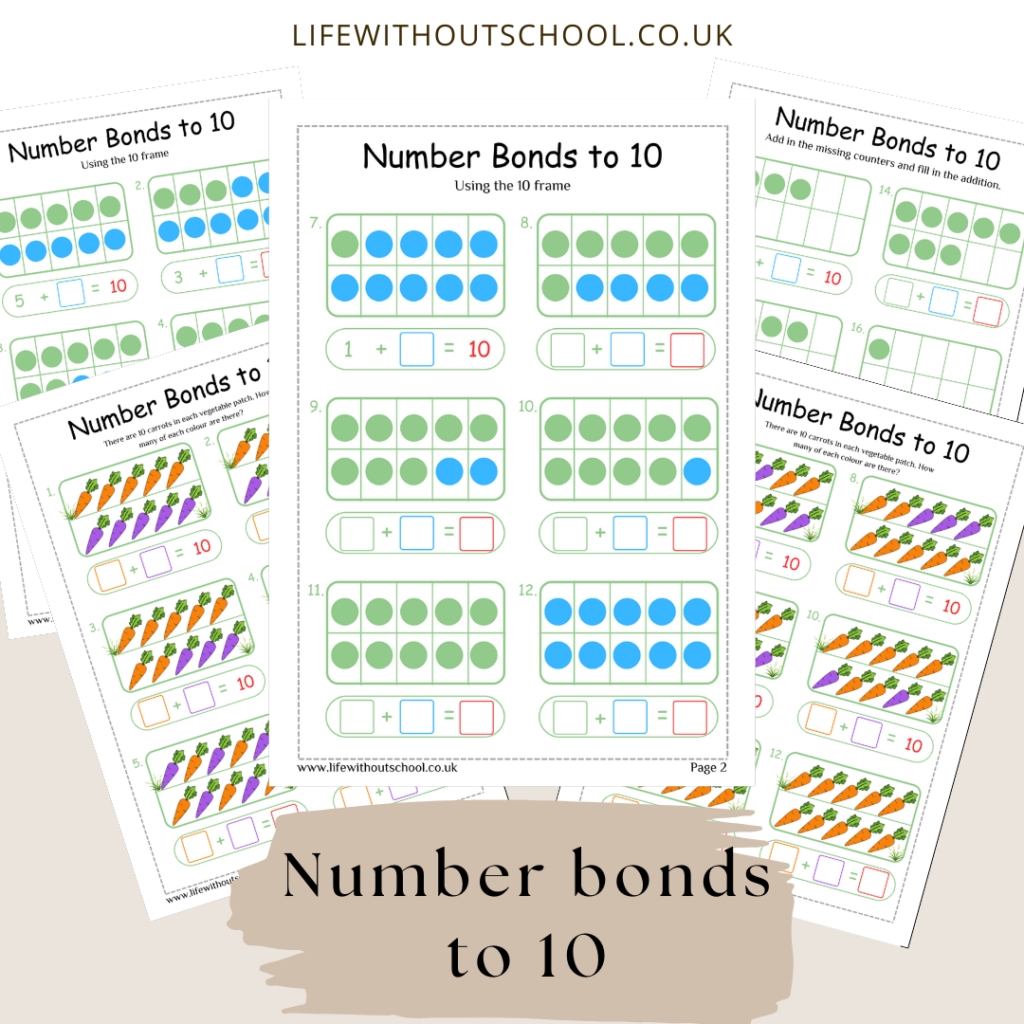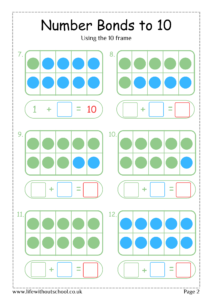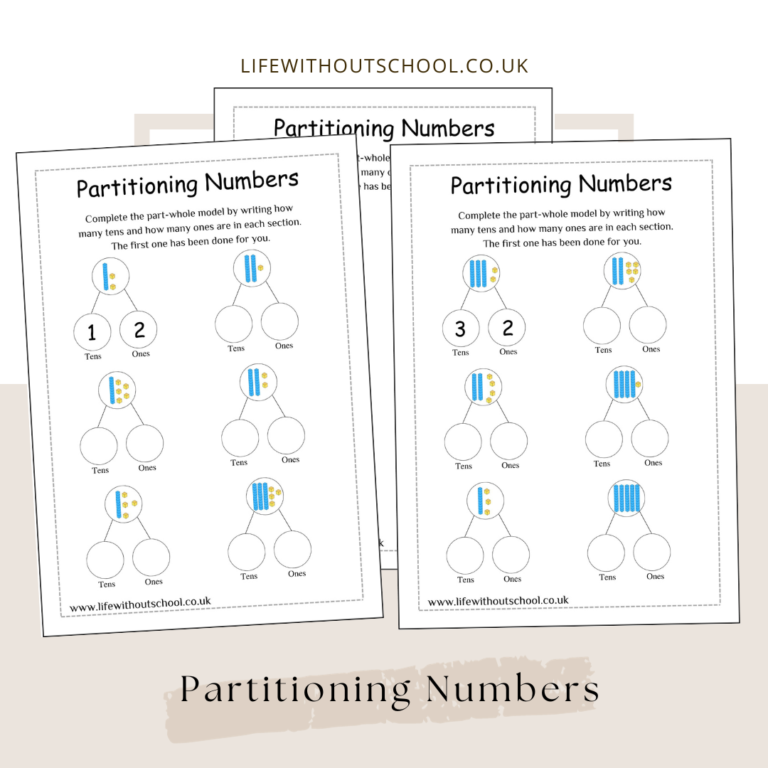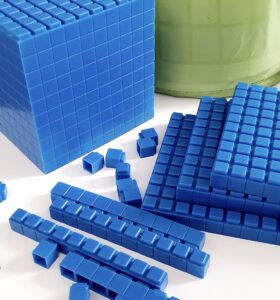Number Bonds to 10 Worksheets
Number Bonds to 10 Worksheets FREE Printable PDF

Number bonds.
What are they and why are they so important?
These worksheets are aimed at helping your child learn the number bonds to 10.
So, what are number bonds?
When teaching about numbers, it’s important for children to know which numbers “bond” together to make a certain number. So usually children are taught number bonds to 5, 10 and 20.
For example if you are teaching number bonds to 10, you are teaching which pair of numbers make 10. The aim is to teach your child all pairs of numbers that make 10.
So you would teach, 9 and 1 make 10, 8 and 2 make 10 and so on.
Teaching number bonds is EXTREMELY helpful when it comes to teaching and learning mathematics. It’s the difference between quick mental arithmetic and working out basic sums using your fingers.
I usually like to start by teaching number bonds to 5/10/20 and the rest then becomes much easier.

Number bonds to 10
This download consists of 5 worksheets which focus on teaching number bonds to 10.
They have been created to really help your child understand and break down what is happening so rather than just memorising the number bonds, they can get a deeper understanding of how and why. Hopefully by the end of all 5 worksheets they will have a much clearer grasp of number bonds to 10.
Working with number bonds encourages critical thinking and problem-solving skills. It will require your little student to figure out different ways to break down or combine numbers to make 10. This is honestly such an important skill and when they finally start to grasp it, it will change the game for them!
Beginning to learn number bonds is like a domino effect for maths. Once they know 4 + 6 = 10, they will find it much easier to understand 14 +6 = 20 and 24 + 6 = 30, and even 24 + 26, and the cycle continues.
When working with kids, it’s often very clear who knows their number bonds and who doesn’t.
It's so important to allow plenty of time to lay this foundation for your child's mathematics development.
Often we feel the need to rush past this stage so they can excel further on, but I honestly cannot stress enough the importance of working hard at the early stages! This stage will determine how the rest of the journey goes.
A weak foundation will never support a sturdy structure!
At this age learning may take longer but it’s crucial to allow your child ample time to get through it, at their own pace.
Once they can get familiar with the concept it will make their life (and yours) SO much easier!
Although many toddlers love to do worksheets because it makes them feel like they are like their older siblings or friends, it’s important to teach through play too. Especially since they are so young and learning through play has been proven to be so beneficial! With that in mind I have a simple game idea for you to try. It’s the same thing as the worksheets, just a little more hands on and more fun!
Number bonds game

Teaching number bonds doesn’t have to be complicated.
You could simply create a 10 square grid (similar to the one in the worksheets) on the floor using masking tape and give your child 10 items to put inside the squares. Then take away 3 and ask what’s left? Then discuss how 7 and 3 make 10.
Keep going with more numbers, taking turns with your child. Also making sure you repeat the same numbers many times so that by the end of the game your child is able to shout out the numbers much quicker.
It’s a simple yet fun and highly effective practice that can make such a difference and best of all, costs nothing! Yay!
I feel like any activity which is made “big” immediately grabs the attention of children and just seems like it will be so much more fun than if it was regular sized!
Download Your Number Bonds Freebie!
Disclaimer: This site may contain affiliate links. This means that I get a tiny percentage every time someone purchases a recommended item. Having said that I NEVER recommend something we don’t use and love.
Before you go!
Following on from number bonds, one of my favourite things to teach in maths is the “part - whole model”
I have to say the White Rose Education maths books really broke this down so well!
The year 2 books in particular were a big favourite of mine because not only did they break down the “part-whole” model. But there was also a lot of practice with the skill. One thing I usually find with workbooks is that it feels like many of them are sort of skimming over certain topics and the child doesn’t get enough practice to really cement that skill. So it was refreshing seeing plenty of practice questions in the White Rose Education books.
Where to begin
Partitioning numbers is the perfect starting point when teaching your child maths.
At the beginning of your child’s mathematics journey it’s important to spend time working on the foundation of their knowledge.
As with everything, without a strong foundation, the structure above won’t be very sturdy.
These worksheets show a brilliant method explaining how to break numbers up into “tens” and “Units/Ones”.
It’s important for them to grasp place value before moving on.
I used these with my children and I absolutely loved how well they understood what was being taught.
We use and highly recommend Base 10 – Click here to get yours.
It’s not vital to have the base 10 resource to help with this work but it is quite helpful.

Teaching Place Value
There are many different maths manipulative products available out there so you don’t need to go with base 10 if you have another preference.
However I would emphasise the importance of investing in some (whichever they may be) as they really help bring the numbers to life and make the whole process much clearer and less daunting for your child.
When visually learning place value, children learn that the position of a digit in a number determines its value, making numbers much easier for your child to comprehend.
I prefer base 10 simply because they really break down the numbers into bitesize, easy to digest pieces. This is where we explain partitioning numbers and part whole models.
The books I use to teach my younger children maths have questions which show base 10. We are able to pull them out and use them alongside our books and it’s made such a difference!
I didn’t do this with my older children so I can see how the younger kids have progressed far quicker while using them.
I’ve linked some base 10 blocks HERE if you want to get your hands on some.

